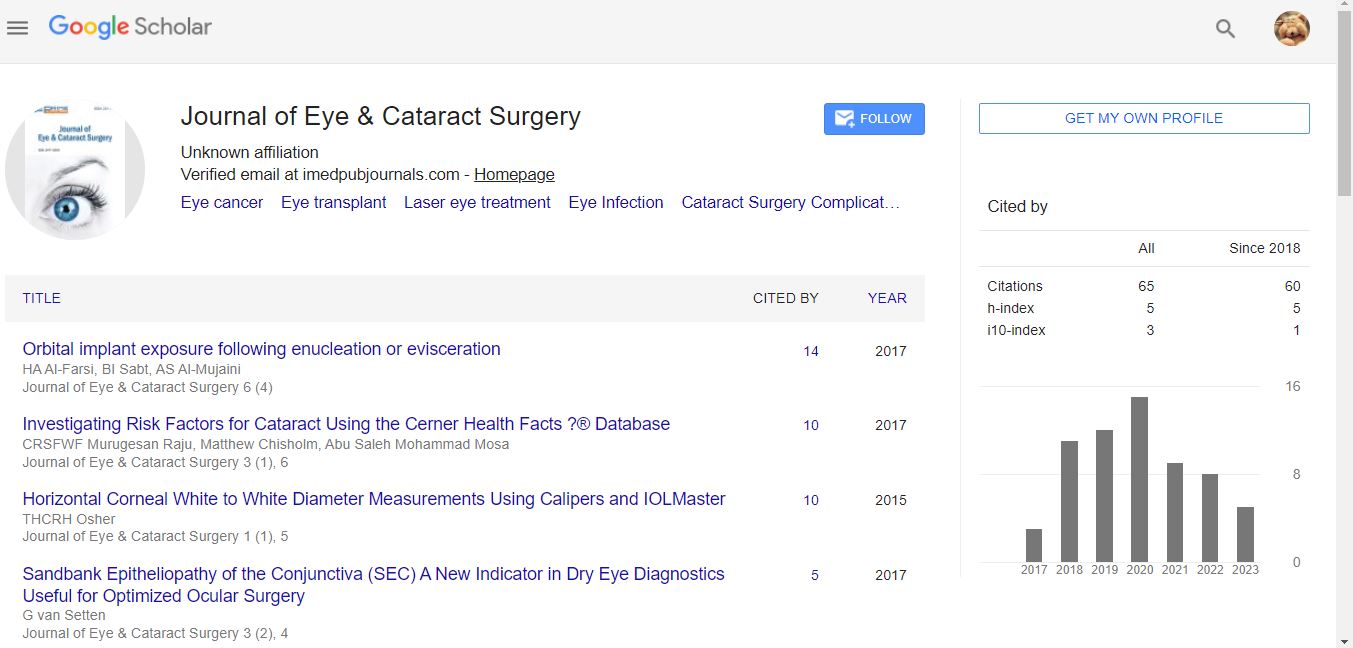Perspective - (2024) Volume 10, Issue 3
A Comprehensive Exploration of Astigmatism: Causes, Symptoms, and Treatment
Cross Elijah*
Department of Ophthalmology, University of Health Sciences, USA
*Correspondence:
Cross Elijah,
Department of Ophthalmology, University of Health Sciences,
USA,
Email:
Received: 02-Sep-2024, Manuscript No. IPJECS-24-21689;
Editor assigned: 04-Sep-2024, Pre QC No. IPJECS-24-21689 (PQ);
Reviewed: 18-Sep-2024, QC No. IPJECS-24-21689;
Revised: 23-Sep-2024, Manuscript No. IPJECS-24-21689 (R);
Published:
30-Sep-2024, DOI: 10.36648/2471-8300.10.3.29
Introduction
Astigmatism is a common refractive error that affects millions
of people worldwide, often leading to blurred or distorted
vision. It arises from an irregular curvature of the cornea or lens,
preventing light from focusing evenly on the retina. This condition
can be present at birth or develop later in life due to various
factors, including eye injury, disease, or surgery. Understanding
the nuances of astigmatism is essential for both patients
and healthcare providers, as early diagnosis and appropriate
management can significantly enhance visual quality and overall
quality of life. In a healthy eye, the cornea and lens have a
symmetrical shape, allowing light rays to converge at a single
point on the retina. However, in individuals with astigmatism,
the cornea may be more curved in one direction than another,
resembling the shape of a football rather than a basketball.
Description
This irregularity causes light to focus on multiple points, either
in front of or behind the retina, resulting in distorted or blurred
vision at all distances. Patients often report difficulty seeing
fine details, experiencing visual discomfort, or suffering from
eye strain, particularly after prolonged periods of reading or
computer use. Astigmatism can be classified into two main
types: regular and irregular. Regular astigmatism is characterized
by a consistent curvature of the cornea in one direction, while
irregular astigmatism involves more complex distortions that
can result from conditions such as keratoconus or corneal
scarring. Regular astigmatism is typically more common and
easier to correct, while irregular astigmatism may require
more specialized treatment options. Diagnosis of astigmatism
is straightforward and usually involves a comprehensive eye
examination conducted by an eye care professional. These
lenses are specially designed to counteract the uneven curvature
of the cornea, allowing light to focus correctly on the retina.
Toric lenses, specifically created for astigmatism, are frequently
used and are available in both glasses and contact lens forms.
Many patients find significant improvement in their vision
with the use of these lenses, leading to greater visual comfort
and functionality in daily activities. In cases where corrective
lenses are insufficient or undesirable, refractive surgery may be
considered. These surgeries have gained popularity due to their
effectiveness and rapid recovery times. However, not all patients
are candidates for these procedures, and a thorough evaluation
by an ophthalmologist is necessary to determine the best
course of action. Beyond traditional treatment options, recent
advancements in technology have led to the development of
new approaches for managing astigmatism.
Conclusion
Regular eye examinations are essential for early detection,
particularly in children, as undiagnosed astigmatism can lead
to amblyopia or “lazy eye,” where vision in one eye fails to
develop properly. In conclusion, astigmatism is a prevalent
refractive error that can significantly impact visual acuity and
quality of life. With advancements in diagnosis and treatment,
patients can achieve improved vision and comfort. Ongoing
research and technological developments promise to enhance
our understanding and management of this common condition,
ultimately benefiting millions affected by astigmatism around
the globe. Early diagnosis and appropriate interventions remain
crucial for optimizing visual outcomes and ensuring a better
quality of life for those impacted.
Citation: Elijah C (2024) A Comprehensive Exploration of Astigmatism: Causes, Symptoms, and Treatment. J Eye Cataract Surg.
10:29.
Copyright: © 2024 Elijah C. This is an open-access article distributed under the terms of the Creative Commons Attribution Li�cense, which permits unrestricted use, distribution, and reproduction in any medium, provided the original author and source
are credited.

